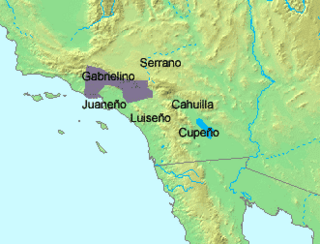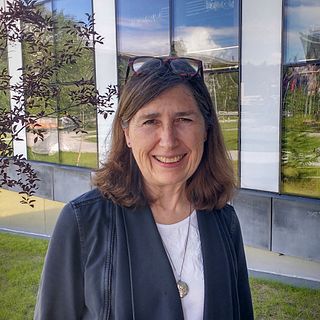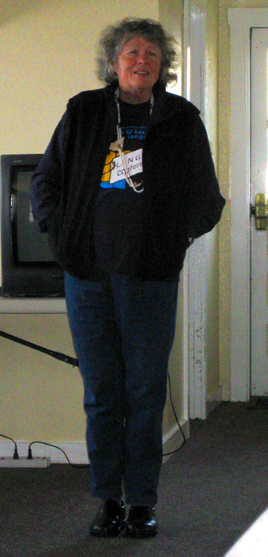
An endangered language or moribund language is a language that is at risk of disappearing as its speakers die out or shift to speaking other languages. Language loss occurs when the language has no more native speakers and becomes a "dead language". If no one can speak the language at all, it becomes an "extinct language". A dead language may still be studied through recordings or writings, but it is still dead or extinct unless there are fluent speakers. Although languages have always become extinct throughout human history, they are currently dying at an accelerated rate because of globalization, mass migration, cultural replacement, imperialism, neocolonialism and linguicide.

The Rumsen language is one of eight Ohlone languages, historically spoken by the Rumsen people of Northern California. The Rumsen language was spoken from the Pajaro River to Point Sur, and on the lower courses of the Pajaro, as well as on the Salinas and Carmel Rivers, and the region of the present-day cities of Salinas, Monterey and Carmel.

The Tongva language is an extinct Uto-Aztecan language formerly spoken by the Tongva, a Native American people who have lived in and around modern day Los Angeles for centuries. It has not been a language of everyday conversation since the 1940s. The Gabrielino people now speak English but a few are attempting to revive their language by using it in everyday conversation and ceremonial contexts. Presently, Gabrielino is also being used in language revitalization classes and in some public discussion regarding religious and environmental issues. Tongva is closely related to Serrano. The names of several cities and neighborhoods in Southern California are of Tongva origin, and include Pacoima, Tujunga, Topanga, Azusa, Cahuenga in Cahuenga Pass and Cucamonga in Rancho Cucamonga.
The Endangered Language Fund (ELF) is a small non-profit organization based in New Haven, Connecticut. ELF supports endangered language maintenance and documentation projects that aim to preserve the world's languages while contributing rare linguistic data to the scientific community.

Patricia Alice Shaw is a Canadian linguist specializing in phonology and known for her work on First Nations languages.
An indigenous language, or autochthonous language, is a language that is native to a region and spoken by indigenous peoples. This language is from a linguistically distinct community that originated in the area. Indigenous languages are not necessarily national languages but they can be; for example, Aymara is an official language of Bolivia. Also, national languages are not necessarily indigenous to the country.
Ipay, also known as 'Iipay or Northern Diegueño, is the Native American language spoken by the Kumeyaay people of central San Diego County, California. Hinton (1994:28) suggested a conservative estimate of 25 surviving Ipai speakers.
Kumeyaay (Kumiai), also known as Central Diegueño, Kamia, 'Iipay Aa, and Campo, is the Native American language spoken by the Kumeyaay people of southern San Diego and Imperial counties in California.

The National Anthropological Archives is the third largest archive in the Smithsonian Institution and a sister archive to the Human Studies Film Archive. The collection documents the history of anthropology and the world's peoples and cultures, and is used in indigenous language revitalization. It is located in the Smithsonian's Museum Support Center in Suitland, Maryland, and is part of the Department of Anthropology at the National Museum of Natural History.
The Survey of California and Other Indian Languages at the University of California at Berkeley documents, catalogs, and archives the indigenous languages of the Americas. The survey also hosts events related to language revitalization and preservation.
Margaret Langdon was a US linguist who studied and documented many languages of the American Southwest and California, including Kumeyaay, Northern Diegueño (Ipai), and Luiseño.

Leanne Hinton is an American linguist and emerita professor of linguistics at the University of California at Berkeley.
Jason Baird Jackson is an American anthropologst who is Professor of Folklore and Anthropology at Indiana University Bloomington. He is "an advocate of open access issues and works for scholarly communications and scholarly publishing projects." At IUB, he has served as Chair of the Department of Folklore and Ethnomusicology and as Director of the Folklore Institute. According to the Journal of American Folklore, "Jason Baird Jackson establishes himself as one of the foremost scholars in American Indian studies today."
Daryl Baldwin is an American academic and linguist who specializes in the Myaamia language. An enrolled member of the Miami Tribe of Oklahoma, Baldwin has served as a member of the cultural resource advisory committee of the Miami Tribe.
Colleen M. Fitzgerald is an American linguist who specializes in phonology, as well as language documentation and revitalization, especially with Native American languages.
Canadian Indigenous Languages and Literacy Development Institute (CILLDI) - an intensive annual "summer school for Indigenous language activists, speakers, linguists, and teachers" - hosted at the University of Alberta, Edmonton - is a "multicultural, cross-linguistic, interdisciplinary, inter-regional, inter-generational" initiative. CILLDI was established in 1999 with one Cree language course offered by Cree speaker Donna Paskemin. By 2016 over 600 CILLDI students representing nearly 30 Canadian Indigenous languages had participated in the program and it had become the "most national of similar language revitalization programs in Canada aimed at the promotion of First Peoples languages." CILLDI - a joint venture between the University of Alberta and the University of Saskatchewan - responds to "different sociolinguistic situations in language communities under threat" and includes three faculties at the University of Alberta in Edmonton - Arts, Education, and Native Studies. CILLDI provides practical training to students which is "directly implemented back in the community." Initiatives like CILLDI were formed against the backdrop of a projection of a catastrophic and rapid decline of languages in the twenty-first century.
The Documenting Endangered Languages (DEL) program is a joint effort between the National Science Foundation (NSF) and the National Endowment for the Humanities (NEH) to help fund fieldwork, research, and community activities that are involved in recording, documenting, and archiving endangered human languages. Linguists estimate that more than 3,000 of the 6,000-7,000 languages currently spoken will soon be extinct due to the diminishing number of speakers who pass along knowledge of their first languages to their children, and fewer daily activities that occur in these home languages. To address this issue, the NSF and NEH—in partnership with the Smithsonian Institution's National Museum of Natural History (NMNH) serving as a research host, but in a non-funding role—announced the first DEL awards in 2005, in an attempt to preserve records of endangered languages in use.
Helen Aristar-Dry is an American linguist who currently serves as the series editor for SpringerBriefs in Linguistics. Most notably, from 1991 to 2013 she co-directed The LINGUIST List with Anthony Aristar. She has served as principal investigator or co-Principal Investigator on over $5,000,000 worth of research grants from the National Science Foundation and the National Endowment for the Humanities. She retired as Professor of English Language and Literature from Eastern Michigan University in 2013.
Lenore A. Grenoble is an American linguist specializing in Slavic and Arctic Indigenous languages. She is currently the John Matthews Manly Distinguished Service Professor and chair at University of Chicago.





